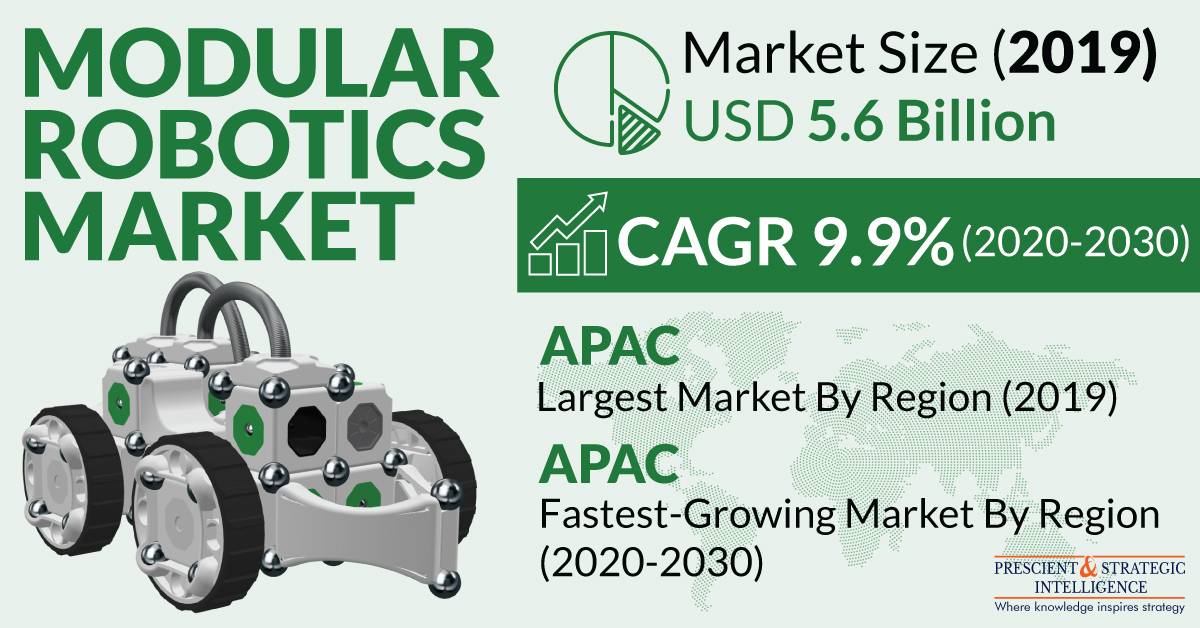Why Are Modular Robots Important Part of Industry 4.0 Standards?
From $9.32 trillion in 2009, the manufacturing output, value-added, rose sharply to $13.672 trillion in 2019, as per the World Bank. This reflects both the burgeoning demand for every type of product, on account of the booming population, and the continuous advancements the manufacturing industry is undergoing to meet it. One of the best ways to boost productivity is automation, as it speeds up the process and makes it almost non-stop.
To download free sample pages of this report@ https://www.psmarketresear...
Thus, with the Industrial 4.0 revolution sweeping across the world, P&S Intelligence expects the modular robotics market revenue to grow from $5.6 billion in 2019 to $15.1 billion by 2030, at a 9.9% CAGR between 2020 and 2030. Most large factories have robots to handle repetitive and critical processes, which also helps reduce companies’ operational expenditure. Robots are precise, can work throughout the day, and do not require salaries and fixed off days. However, since a factory may need an array of robots for different tasks, industrial automation can increase the initial capital investments.
As a result, manufacturers have begun integrating modular robots into their operations, as these systems can change their shape and size automatically, by changing the position of their individual active and passive components, much like in the Transformers movies. Thus, one robot can function in an array of settings within a factory, by reconfiguring itself, which could help companies save on capital expenditure and make the overall manufacturing process cheaper. This, in turn, would help industrialists reduce the prices of their end products and gain a wider consumer base.
With countries around the world investing in the advancement of their industrial sector to become a manufacturing hub, modular robots are being further improved via the integration of artificial intelligence (AI). Many companies in the robotics sector are now integrating AI in such products to analyze real-time operational data for better efficiency in the factory, as well as predictive maintenance. For instance, FANUC Corporation introduced the AI path control function in its ARC Mate cutting and welding robots in May 2020, to allow the robots to find their own path on the factory floor using machine learning, AI, and acceleration sensors.
With such advancements, manufacturers are now using a variety of modular robots, including articulated, selective compliance assembly robot arm (SCARA), cartesian, collaborative, parallel, spherical, and cylindrical modular robots. Among these, articulated variants are the most popular because of their ability to handle heavy parts and components in the automotive, plastics, rubber, food & beverages, chemicals, and mining & metal industries. Apart from these, collaborative modular robots are witnessing rapid adoption in factories, as they help reduce the involvement of humans even in the tasks where conventional robots need to work with people.
Therefore, on account of the burgeoning manufacturing activities and the need to make them faster and cost-efficient, Asia-Pacific (APAC) has been the largest modular robotics market till now. Led by China, Japan, South Korea, and India, APAC accounts for the highest industrial output in the world. In addition, governments here are taking steps to improve their manufacturing infrastructure in order to boost exports. Some of these steps are the Made in China 2025, Make in India, and Making Indonesia 4.0 initiatives.
Hence, as governments continue to pour millions into the advancement of their manufacturing sector, the demand for modular robots will keep rising.
From $9.32 trillion in 2009, the manufacturing output, value-added, rose sharply to $13.672 trillion in 2019, as per the World Bank. This reflects both the burgeoning demand for every type of product, on account of the booming population, and the continuous advancements the manufacturing industry is undergoing to meet it. One of the best ways to boost productivity is automation, as it speeds up the process and makes it almost non-stop.
To download free sample pages of this report@ https://www.psmarketresear...
Thus, with the Industrial 4.0 revolution sweeping across the world, P&S Intelligence expects the modular robotics market revenue to grow from $5.6 billion in 2019 to $15.1 billion by 2030, at a 9.9% CAGR between 2020 and 2030. Most large factories have robots to handle repetitive and critical processes, which also helps reduce companies’ operational expenditure. Robots are precise, can work throughout the day, and do not require salaries and fixed off days. However, since a factory may need an array of robots for different tasks, industrial automation can increase the initial capital investments.
As a result, manufacturers have begun integrating modular robots into their operations, as these systems can change their shape and size automatically, by changing the position of their individual active and passive components, much like in the Transformers movies. Thus, one robot can function in an array of settings within a factory, by reconfiguring itself, which could help companies save on capital expenditure and make the overall manufacturing process cheaper. This, in turn, would help industrialists reduce the prices of their end products and gain a wider consumer base.
With countries around the world investing in the advancement of their industrial sector to become a manufacturing hub, modular robots are being further improved via the integration of artificial intelligence (AI). Many companies in the robotics sector are now integrating AI in such products to analyze real-time operational data for better efficiency in the factory, as well as predictive maintenance. For instance, FANUC Corporation introduced the AI path control function in its ARC Mate cutting and welding robots in May 2020, to allow the robots to find their own path on the factory floor using machine learning, AI, and acceleration sensors.
With such advancements, manufacturers are now using a variety of modular robots, including articulated, selective compliance assembly robot arm (SCARA), cartesian, collaborative, parallel, spherical, and cylindrical modular robots. Among these, articulated variants are the most popular because of their ability to handle heavy parts and components in the automotive, plastics, rubber, food & beverages, chemicals, and mining & metal industries. Apart from these, collaborative modular robots are witnessing rapid adoption in factories, as they help reduce the involvement of humans even in the tasks where conventional robots need to work with people.
Therefore, on account of the burgeoning manufacturing activities and the need to make them faster and cost-efficient, Asia-Pacific (APAC) has been the largest modular robotics market till now. Led by China, Japan, South Korea, and India, APAC accounts for the highest industrial output in the world. In addition, governments here are taking steps to improve their manufacturing infrastructure in order to boost exports. Some of these steps are the Made in China 2025, Make in India, and Making Indonesia 4.0 initiatives.
Hence, as governments continue to pour millions into the advancement of their manufacturing sector, the demand for modular robots will keep rising.
10 months ago

